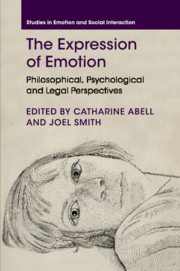Book contents
- Frontmatter
- Contents
- Notes on Contributors
- Acknowledgements
- Introduction: Emotional Expression
- Part I Philosophical Perspectives
- 1 Expressing, Showing and Representing
- 2 Emotions and Their Expressions
- 3 Expressive Actions
- 4 Emotional Expression, Commitment and Joint Value
- 5 Collective Emotion and the Function of Expressive Behaviour
- Part II Psychological Perspectives
- Part III Legal Perspectives
- Index
- Miscellaneous Endmatter
- References
3 - Expressive Actions
from Part I - Philosophical Perspectives
Published online by Cambridge University Press: 05 September 2016
- Frontmatter
- Contents
- Notes on Contributors
- Acknowledgements
- Introduction: Emotional Expression
- Part I Philosophical Perspectives
- 1 Expressing, Showing and Representing
- 2 Emotions and Their Expressions
- 3 Expressive Actions
- 4 Emotional Expression, Commitment and Joint Value
- 5 Collective Emotion and the Function of Expressive Behaviour
- Part II Psychological Perspectives
- Part III Legal Perspectives
- Index
- Miscellaneous Endmatter
- References
Summary
Introduction: Hursthouse's Puzzle
In a well-known paper, Rosalind Hursthouse argues that certain common, and not irrational, actions cannot be accommodated by the dominant philosophical model of the rational explanation of action (Hursthouse 1991). Examples of the category Hursthouse has in mind would include rumpling someone's hair (out of affection or tenderness); jumping in joy or excitement; destroying something connected with a particular person in anger; covering one's face (in the dark) from shame or fear; ‘puffing oneself up’ with pride; and caressing the clothes of a loved one in grief.
Hursthouse's claim is that (1) these are examples of actions, since they are intentional rather than merely involuntary reflexes (the agent is in some way in rational control of the way she acts); (2) such behaviour is not irrational, but (3) they are not done ‘for a reason’ in the sense that there is something that the agent takes as counting in favour of acting thus. It is not the case that, in jumping for joy as the ball goes in the net, I am doing so because I believe that this will bring about a state of affairs towards which I have some pro-attitude. On these grounds, she thinks, these actions cannot be accommodated by the dominant model of rational explanation of action, where actions are explained by reference to the purpose the agent had in so acting. She doesn't question the validity of that model, and therefore terms these actions ‘arational’. But although there is no rational explanation, she claims, there is a good explanation for this action: it was done out of joy (and behaviour like that is within the normal range of behaviour to which joy leads). She argues that the way we explain these actions, which the dominant model cannot accommodate, is by seeing them as expressions of emotion. Explaining action as the expression of emotion, however, is quite a different kind of explanation of action from what she takes to be the standard form of rational explanation in which we explain action by citing some feature that an agent took to count in favour of the action.
In this chapter I argue that we can reject Hursthouse's conclusion that explanation of action as the expression of emotion is sui generis if we have a sufficiently broad understanding of how features can count in favour of actions.
- Type
- Chapter
- Information
- The Expression of EmotionPhilosophical, Psychological and Legal Perspectives, pp. 73 - 94Publisher: Cambridge University PressPrint publication year: 2016
References
- 9
- Cited by



